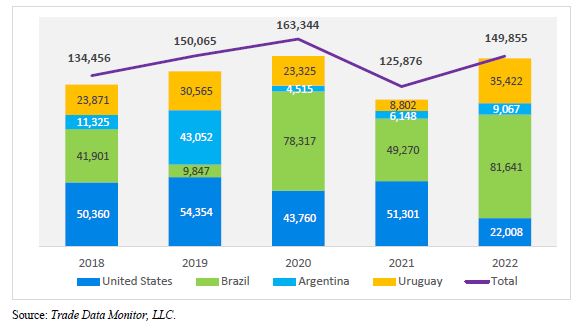 Costa Rica Rice Imports by Origin by Calendar Year (MT milled rice equivalent)
Costa Rica Rice Imports by Origin by Calendar Year (MT milled rice equivalent)
Apr 25, 2024
ARLINGTON, VA – In 2022, like many countries around in the world, Costa Rica’s government looked for ways to curb food price inflation. That summer, President Rodrigo Chaves Robles announced the reduction of tariffs on rough and milled rice, the staple carbohydrate in the Costa Rican diet. The Presidential Decree reduced tariffs on rough and milled rice from 35 percent to 3.5 and 4 percent, respectively, and with an additional 1 percent import tax, the duty rate for each rice type totaled 4.5 and 5. Despite U.S. rice having preferential market access under the Central America-Dominican Republic-USA free trade agreement (CAFTA-DR), this Decree opened the floodgates to cheap South American rice.
Unfortunately for U.S. rice and Costa Rican rice farmers, this decision was only beneficial for third-country origin rice exporters. By August 2023, U.S. rice exports plummeted and rice production in Costa Rica declined sharply. From January-August 2023, U.S. rice exports fell 89 percent to only $818,000, down from $7.7 million during the same period the year prior. By August 2023, the U.S. Department of Agriculture’s Foreign Agricultural Service (FAS) estimated that domestic production in Costa Rica would fall by 60 percent from the previous marketing year.
After receiving complaints from domestic rice farmers, a Costa Rican administrative court suspended the Executive Decree earlier this month. Despite an appeal from President Chaves, the Costa Rican online tariff schedule restored the import tariffs for third-country origin rice to 35 percent.
Of note, 2024 is the nineteenth year of the implementation of the CAFTA-DR, which allows for a duty-free quota for U.S. rice of 69,000 metric tons for rough rice and 9,750 metric tons for milled rice. In 2025, the quota will be eliminated, and U.S. rice will have free market access, including the elimination of the 1 percent import tax.
While this exciting news should be celebrated, skepticism has grown over the government’s ability to facilitate the trade following a 2022 cyber-attack on the Costa Rican Ministry of Foreign Trade’s (COMEX) computer systems. COMEX uses historical calculations of imported volumes by historical quota holders (80 percent of the volume is allocated to historical importers and the other 20 percent for new entrants). Unfortunately, the cyber-attack created a gap of official data. COMEX is working through administrative procedures to verify self-reported import volumes and is facing several legal challenges potentially creating an even lengthier delay for U.S. rice exports.
Todd Burich, vice president of rice marketing with ADM Rice and chair of the USA Rice Western Hemisphere Trade Policy Subcommittee, is hopeful that U.S. rice will significantly rebound in the coming year. “While these dynamics certainly create layers of uncertainty, FAS San Jose anticipates COMEX will be able to allocate the 2024 quota volumes by the end of the month. We are hopeful for a full recovery for U.S. rice in the market.”